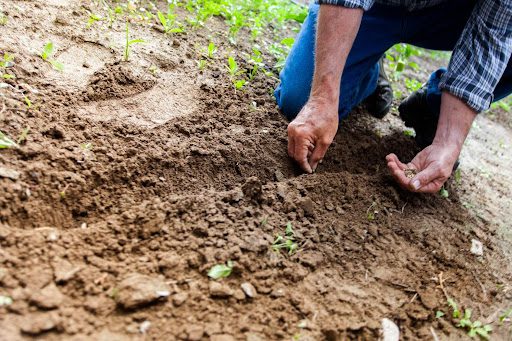Companion planting is the act of planting two or more plants together for mutual benefit. The theory behind companion planting is that certain plants can help each other grow better, resist pests and diseases, and even improve flavor. While companion planting has been around for centuries, it’s recently enjoying a resurgence in popularity as Maine gardeners are looking for new ways to improve their yields and make their gardens more sustainable.
In this blog, we will discuss what companion planting is, how it benefits your garden, tips to keep in mind when companion planting, and some of the best combinations for a Maine garden.
The Basics of Companion Planting
Companion planting is a form of intercropping, or growing different crops in the same space. This technique is based on the idea that certain plants can help each other grow and resist pests and diseases. For instance, some plants provide natural “companions” to help them fight pests—some herbs produce strong odors that repel insects, while others attract beneficial insects like bees and ladybugs. Other plants may help fix nitrogen in the soil or provide shade for their companions.
Simply put, you are essentially creating a mini-ecosystem in your garden. Each plant provides something that the others need to thrive—some plants provide nutrients, some attract beneficial insects, and others discourage pests. The key is to choose plants that complement each other instead of competing for resources. This way, your garden will be well-balanced, and everyone will benefit from living together!
How Does Companion Planting Benefit My Garden?
The list of benefits from companion planting is long and varied. Here are just a few of the advantages you can expect to see in your Maine garden.
Deterring Pests
One of the most popular reasons for companion planting is to deter pests. Certain plants give off natural chemicals that repel certain insects. For example, marigolds release a limonene chemical that repels mosquitoes, aphids, and some root-knot nematodes. Nasturtiums contain high levels of sulfur, which deters cabbage butterflies and whiteflies. And chrysanthemums produce pyrethrins, which are toxic to roaches, Japanese beetles, ants, and more.
Improved Soil Quality
Companion planting can also help improve the quality of your soil. Certain plants, such as legumes, are nitrogen-fixers—they absorb nitrogen from the air and “fix” it into the soil for other plants to use. This helps ensure your soil is well-nourished and full of nutrients for all of your plants.
A few examples of plants that improve soil health are comfrey, alfalfa, and buckwheat—these are known as “green manure” crops and can be plowed under to improve soil tilth (texture). Green manure crops are typically planted in the fall, so they have time to break down over winter before being tilled into the soil in the spring.
Attracting Beneficial Insects
In addition to deterring pests, companion planting can also attract beneficial insects. Many plants produce nectar and pollen that are attractive to pollinators, like bees and butterflies. This is especially important for Maine gardens because the state’s native pollinator population has been declining due to habitat loss and disease in recent years.
They also provide a natural form of pest control. For example, flowering herbs like dill and parsley attract hoverflies that feed on aphids and other pests. Attracting beneficial insects to your garden can help ensure it remains healthy and pest-free.
Improved Flavor & Aroma
Companion planting can also improve the flavor and aroma of your fruits and vegetables. Growing certain herbs near your vegetables can help enhance their flavor and attract beneficial insects. For instance, oregano planted near tomatoes will give them a strong tomato-oregano flavor, while basil planted near peppers will bring out their sweetness.
Creates Biodiversity
Growing different crops in the same space creates a more diverse and resilient ecosystem. This is especially important for Maine gardens because our climate can be unpredictable. If one crop fails due to extreme temperatures or unexpected weather patterns, others may still survive and produce yields.
Increasing Yields
Lastly, companion planting can also increase yields by up to 20%. This is because some plants actually help other plants grow better by providing shade or attracting helpful insects. For example, tall plants like corn can provide shade for shorter plants like lettuce in the summer months when temperatures tend to be higher. Another example is tomatoes—they release ethylene gas when they ripen, which speeds up ripening in nearby fruits like melons.
Tips for Companion Planting Success
Maine’s unique climate and soil can make companion planting a bit tricky. Here are some tips to keep in mind for success:
Choose Plants That Complement Each Other
The most important thing to remember when companion planting is to choose plants that are compatible with each other. You want to ensure your plants get the right amount of nutrients, light, and water for optimal growth. For example, tomatoes and carrots are a great companion planting duo because they both need lots of nutrients and sunlight.
Start Small
It’s best to start small when you first begin companion planting. This will allow you to experiment with different plant combinations without investing too much time or money. As you get more comfortable with companion planting, you can expand your garden and include more plants that complement each other!
Consider The Size Of Each Plant
When choosing plants for companion planting, consider the size of each plant. Taller species should be planted on the north side of shorter plants to give them more access to sunlight. For example, corn should be planted on the north side of shorter plants like lettuce. It’s also important to leave enough space between each plant, so they have plenty of room to grow and flourish.
Consider Your Site Conditions
Be sure to consider the conditions of your site when choosing companion plants. Are you in a sunny spot or a shady area? Does your soil drain well, or is it prone to standing water? Knowing these things can help you decide which plants will work best for you.
Rotate Your Crops
Another way to ensure success with companion planting is to rotate crops each year. This helps break pest and disease cycles, keeps nutrients balanced in the soil, and ultimately gives better yields.
Plant Other Helpful Elements
In addition to pairing up plants, consider adding things like trellises and birdhouses to your garden. These elements can provide additional protection for your plants, attract helpful insects and birds, and help create an attractive outdoor space!
Choose Plants That Grow At Different Rates
It’s also a good idea to stick with plants that grow at different rates so you can stagger harvests throughout the season. This will ensure you always have something to harvest in your garden!
Pay Attention To Weather Conditions
Lastly, pay attention to weather conditions such as temperature and rainfall levels—these can determine which plants will do best in your area. Maine’s climate is known for its cold winters and short growing seasons, so consider this when choosing plants for your garden.
Best Plant Combinations for Maine Gardens
Many combinations of plants can be used for companion planting, but some combinations are more effective than others. Here are a few examples of effective companion plantings:
Tomatoes & Basil
Tomatoes and basil are a classic combination—basil helps repel insects from tomato plants, while tomatoes release ethylene gas which speeds up the ripening of nearby fruits like melons.
Cabbage & Tomatoes
Cabbage deters tomato hornworms—a common pest that attacks both cabbage and tomatoes—while tomatoes improve the flavor of cabbage when cooked together in soup or stew.
Carrots & Radishes
Carrots and radishes make great companions because both require similar soil conditions and don’t compete for resources.
Lettuce & Spinach
Both lettuce and spinach need plenty of water, so planting them together ensures they’ll stay hydrated. The tall leaves of the lettuce also provide some shade for the spinach in hotter temperatures.
Squash & Pumpkins
Squash and pumpkins are a great combination—they make use of the same space and don’t require much care. They also attract beneficial insects like bees, which can help pollinate other plants in your garden.
Closing Thoughts
Companion planting is an effective way to get the most out of your Maine garden. By selecting compatible plants, rotating crops, and taking into account site conditions, you can create a healthy and productive garden that will yield delicious fruits and vegetables all season long! With some patience and experimentation, you’ll soon be reaping the rewards of companion planting in no time.
Are you ready to maximize the health of your garden and create a thriving environment for plants and pollinators? Stone Solutions Maine can help you create a plan for companion planting to create a happy, healthy, and beautiful garden! Contact us about our landscaping services today!

